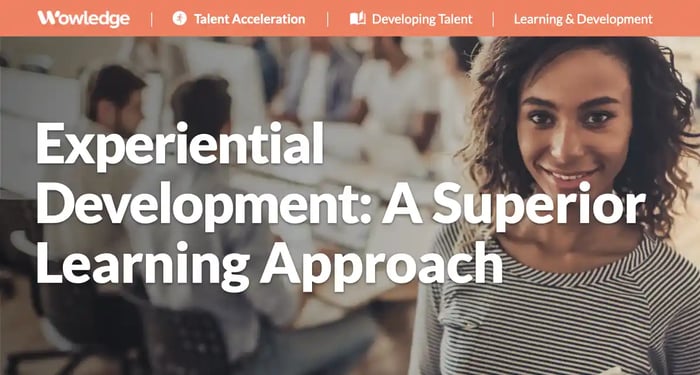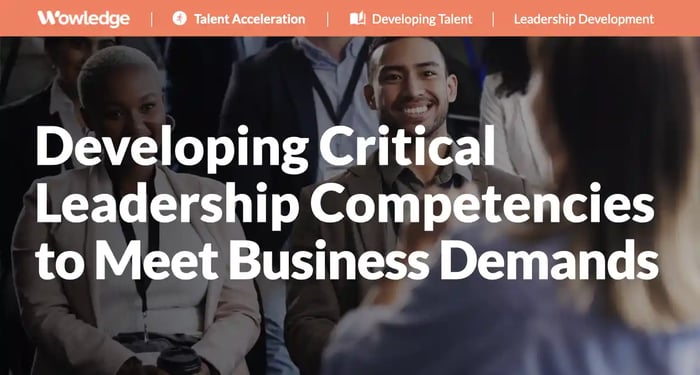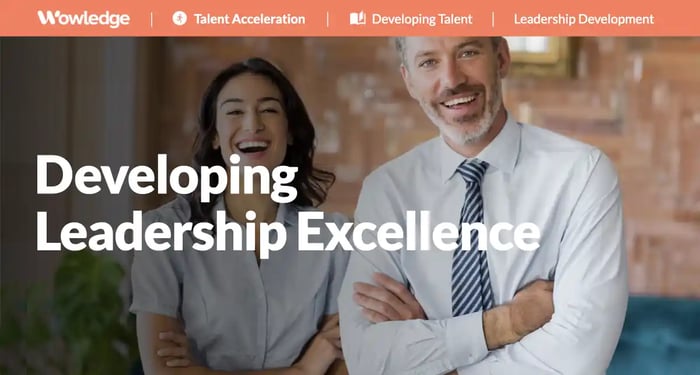Table of Contents
Organizations across industries and the globe are finding themselves in need of adapting to rapidly advancing technologies and significant labor shortages. Their focus on making related changes to process workflows and job content has pressured learning and development (L&D) teams to enhance and create responsive skills development methods. While traditional classroom and eLearning methods continue to dominate, experiential development can more significantly impact the speed and effectiveness of those needed outcomes.
That pressure is real, as the World Economic Forum says employers across the globe report that, on average, 39% of their workers’ core skills will need to change by 2030. Even today, the skills in most demand (analytical thinking, flexibility and agility, leadership, creative thinking, and self-awareness) can be challenging to develop when relying primarily upon instructor-led and eLearning methods.
Similarly, among the skills emerging as the top priorities over the next five years (AI and Big Data, analytical thinking, creative thinking, curiosity, empathy, and active listening), developing and building competency using traditional (didactic) methods is also challenging. However, experiential development offers an exciting and compelling option to build and enhance those.
Unfortunately, as Deloitte has reported, only 20% of organizations use experiential learning, while 84% say that focusing on experiences is a superior method of preparing employees for work challenges.
Experiential development defined
Experiential development is simply the act of learning by experience. It brings context to the material or skill being developed by letting learners interact with the subject matter and learn how to properly and/or effectively use it to accomplish work tasks. It is a hands-on approach augmented by expert observation and coaching that guides the learner on a personalized journey of understanding.
Experiential learning is a learning method or process that also engages and builds employee capabilities in experimentation, problem-solving, decision-making, and collaboration. It can be combined with pre-reading, classroom or eLearning, group discussions, and subsequent performance coaching by peers or managers. Examples of experiential learning range from special projects to simulations and case studies, hands-on coding, and guided tool or machine operation.
The problem with traditional approaches
SHRM research has demonstrated the issues facing companies and their employees at a point in time where their capability growth efforts need to accelerate. Employees point to common frustrations with their employer-provided training, including:
- 33% find it “hard to stay motivated” during training
- 25% say they start forgetting the material soon after training
- 25% complain about having insufficient time to complete the training during work
- 24% report that the training is not relevant to their role
- 21^% say that the content is outdated
The keys, of course, are to offer content that applies to the work they are doing now (or aspire to in the future), keep it interesting and memorable, and support their ability to practice the new skills and apply them to expand their opportunities to contribute to business goals and objectives.
The last one is the essential objective of job and career-based learning. It is the source of a positive return on investment (ROI) of any company-paid or -sponsored skill development activity. It is not the acquisition of new skills that is crucial, but rather the ability of the employee to exercise those to the enhanced benefit of the company, its mission, market growth goals, and customer requirements. Practice and application are the core elements that differentiate experiential development from other organizational learning activities.
With so many organizations leaning heavily on a combination of instructor-led and eLearning for their structured employee development approaches, keeping things fresh, engaging, and relevant to their workers is a must. While so many organizations rely on eLearning for repetitive compliance and other required training, it is surprising that many different job and professional skill topics are delivered in a didactic (lecture or e-learning) manner. For example, 81% of organizations report primarily delivering sales training through these methods, and 73% of professional and industry-based skills development, including desktop applications and IT systems training.
The issue is that many skills are best learned and developed through practice and application. In fact, the same research found that surveyed employees reported that the most effective development involved on-the-job training (82%), informal social learning (71%), and job-related performance coaching (19%). Those experiential development methods often generate superior results for employees and their organizations.

What makes experiential development so valuable
Integrating active and interactive experiences into learning programming addresses many of the primary objectives of the L&D function. This includes creating learning that builds and expands employee skills (and, when aggregated, corporate talent capabilities), providing engaging and impactful learning that motivates employees to develop continuously, and offering cost-effective programming that enhances productivity while minimizing time away from the job.
The direct benefits of experiential skill development include:
Makes learning “stickier”
Research has demonstrated that experientially based learning methods significantly enhance learning retention. Studies conducted over decades into the “forgetting curve” have found that individuals can forget up to 70% of newly learned information within 24 hours and nearly 90% within a week.
Consider how some of the primary elements that can improve knowledge retention relate to the design of experiential skills development activities:
- Understanding and meaningfulness. The more relevant the information, the more memorable it is.
- Frequency of review. The more the information is revisited and practiced, the more it will be retained.
- Active engagement. Participating in practice sessions and group discussions, explaining the knowledge or skill to others, and applying it in real life enhance memory.
- Repetition over time. Spacing out learning and practice sessions and performing related tasks encourage retention.
- Emotional or personal connection. Linking learned content to personal (e.g., work) experiences strengthens memory.
Related data further supports the notion that different experiential development practices produce substantially higher outcomes and benefits. For example, having learners teach others is said to produce 90% retention, followed by (hands-on) practice by doing (75% retention) and participation in a discussion group (50% retention). Compare those results to less interactive methods, such as watching a demonstration at only 30% retention, audio-visual at 20%, reading at 10%, and lecture at only 5% retention of the delivered content.
It is scientifically proven
Research has demonstrated the effectiveness of experiential development, with key learnings and some exciting outcomes for employees and their organizations. It brings the “real-world” relevance that many adult learners insist upon, yielding more credibility and motivation to pay attention during the process. It encourages experimentation as the learner explores and tries to master the concept, topic, or method in a simulated environment. That can lead to the discovery of multiple solutions or applications to the work they are performing currently and in the future. And finally, it enables practicing the skills under the tutelage of an expert who can provide feedback and guidance about refining those to optimize outcomes.
It is more interactive and engaging
The fact that the learner is doing the activity with their own hands while relying upon their existing skills and knowledge of the application(s) for which the content can be used makes experiential development more interesting and engaging. Much like learning in a classroom session, being able to learn while interacting with a direct supervisor, a more senior subject matter expert, or a group of similarly skilled peers, there is a social element that makes learning more engaging and interesting. Compared to a more traditional classroom-only or individualized eLearning approach, there are more opportunities for learning by asking, failing, and hearing other’s questions and ideas.
It is efficient and can keep the worker on the job
Experiential development activities and assignments are often conducted while on the job. They are directly targeted to developing specific knowledge and capabilities related to the current or future potential assignments. As a result, they are attractive and more cost-effective methods from line managers’ perspectives for continued employee development. They can be conducted in multiple sessions over days or weeks and, when well-designed, are often time-bound with a specified beginning and end. As a result, these can be done with less political “friction” and functional bias.
Directly addresses and is responsive to employee preferences
Learners have strong preferences, which are evolving as Millennials and GenZ workers become the dominant generation. Given that 92% of employees report that “learning something new” increases their engagement and motivation, the 83% who say that on-the-job training is more effective than classroom or eLearning requires attention by HR and L&D leaders.
What employees report wanting more of from company-sponsored offerings includes greater relevance of the content to their jobs, more social learning opportunities, and formal skill assessments that presumably give them a sense of skill achievement and increased capabilities. They also say that their most preferred learning methods include simulations (64%), and coaching and mentoring (51%). Each of these elements is common to experiential skill development approaches.
Considering experiential development vs. full-time assignments
Full-time developmental assignments are a form of experiential learning and bring tremendous value to employees and the talent development goals of organizations. Job rotations and apprenticeships are examples of full-time assignments that are designed with a starting and stopping point. However, they are subject to some limiting forces that impact their effectiveness as broad, cross-organizational development activities.
The biggest issue is scale—and the fact that lateral mobility rates are reported as low as 8% per year. This makes development through job movement much less likely to be effective. Secondly, the time and effort it takes to select employees for movement and get them into a new internal role can significantly lessen these impacts on employee engagement and organizational productivity. Finally, the ease employees can effectively upskill with lasting results makes on-the-job development a much more effective and cost-efficient solution.
They are also less targeted regarding skills to be developed, as each role has a range of duties and responsibilities that may or may not offer suitably focused skill development. Moving from Director in one function to VP in another might be effective for developing skills in strategic thinking, cross-functional awareness and collaboration, customer focus, etc. However, it can also require acquiring new knowledge that distracts from learning the targeted skills. On the other hand, a project assignment working with the executive team on the new year’s strategic plan can provide specified skill development.
That said, a movement toward defining career paths through skill development and experiential means rather than career ladder-based advancement is gaining steam. Deloitte reported that 84% of companies responded positively to the movement from careers to experiences. Fuel50 reported that experiences such as stretch assignments, gigs, job rotations, learning assignments, and mentorships were highly satisfying to employees seeking growth and advancement opportunities, yielding up to 30% increased engagement levels when available.

Experiential skills development methods
The reality of bringing experiential development to the organization requires a small but significant shift in priorities by the HR and L&D teams. What makes the necessary shift small is a commitment to creating structured experiential approaches for targeted learning objectives or outcomes.
That means identifying the skills, knowledge, and abilities that can be best and more effectively developed through pure or blended experiential and traditional means. The former requires the creation of leader, facilitator, or coach guides, specified learning and skill objectives, and support materials that can be used to support learners and coaches or facilitators through the process. Learning outcome measurements can take the form of post-experience skill assessments.
The more significant challenge is scaling experiential development approaches to meet the unique needs of different roles, functions, and types of operations. That requires a governance model championed by leadership on organization-wide and local levels. The primary objective is to institutionalize the use of the method, actively engage leadership participation and support, and push the development of these approaches down to a local level where they can be best tailored and implemented with local subject matter experts and managers.
The methods are well-known and are popular with employees. They include:
1. Special project leadership or membership
These are increasingly effective for exposing participants to new skills related to process improvement, product development, customer success, cross-functional requirements, internal network building, outside research, and thought leadership. Project management roles are excellent tests and development paths for high-potential (HiPo) employees and subject matter experts who may be unknown to leadership but are highly valued resources.
The key is to identify members based on more than their expertise and skills as they relate to the team’s needs and, more importantly, their development needs. The skills developed and practiced daily include strategic thinking, innovation and creativity, teamwork and collaboration, and exposure to other organizational functions and businesses' thinking, requirements, and operational requirements.
2. Short-term job rotations
The value of planned 3, 6, or 9-month rotations or assignments in different businesses, roles, and types of operations can be invaluable for employees in several circumstances. This can be used, for example, to help new hires or HiPos learn different aspects of the business or expand the perspectives and ability to collaborate with those working in remote locations or highly specialized operations. These assignments can also bring specialized expertise into business units or functions facing serious challenges or significant change. These are also used effectively as low-cost and -risk development opportunities to test the ability of HiPos or future leaders to effectively adapt, collaborate, and contribute to other functions or businesses.
3. Mentorships
These should be offered as part of a structured process and separately encouraged for self-motivated employees. Formal matching can occur as part of a HiPo or early career guidance process, where leaders, senior managers, and subject matter experts are trained and promoted to be available for regularly scheduled and structured sessions. Support and guidance should be made available to all employees to enable a consistent approach to mentoring relationships and sessions, and monitoring of those should be made part of an effectiveness measurement system.
4. Small team instruction and coaching sessions
Structured team learning and practice sessions can be efficient, especially when introducing new machinery, software, workflows, legal or regulatory requirements, or products and services. Giving employees a chance to learn from an expert(s) and then practicing and asking questions can build an ongoing group learning and support team in the immediate workplace. A series of sessions for initial training, practice, coaching, mastery testing, advanced approach, and application education spread over time can build more significant expertise across a team.
5. One-on-one coaching
Making the development of new skills stick should be integrated into regular manager-employee discussions and performance check-ins. While this may sound obvious, managers need guidance and direction to ensure new skills are developed by everyone needing them on each team. Employees consistently report a desire for coaching from their direct managers, and all members and leaders need to be reminded and held accountable for this type of development continuously.
This extends to skill and career development planning, where managers should be equipped with the knowledge and resources necessary to provide guidance and direction to their subordinates about the skills needed and the opportunities they can provide access to that will accomplish such growth.
6. Special assignments
Talent leaders, executives, and line managers can identify opportunities to develop employees' skills and capabilities arising from ongoing business operations and external events. Examples include a production line issue, an unforeseen challenge with new products or services suddenly facing customers, a new executive wanting to introduce changes, or an acquisition or merger. As they emerge, these should be routinely evaluated as experiential skill development opportunities for employees in different functions, businesses, and job levels.
7. Embedding action learning into traditional learning offerings
A well-designed program for rising leaders, new managers, sales staffers, nurses, or engineers that introduces them to new concepts, methods, or tools can be effectively augmented with action learning projects. These challenge them to implement the learning in a safe environment where coaching and guidance can be offered. They can represent strategic issues facing the company that top leaders identify for course participants to evaluate and propose responsive strategies or tactics. Those are then presented to the leader or a panel of top leaders who can assess and provide feedback and guidance to participating employees.
Relevant Practices & Tools
Advanced Learning and Development Practices to Accelerate Skill and Capability Growth. >
These practices focus on developing, staffing, and managing a learning and development function that is highly responsive to business needs and leverages both technologies and non... more »
Creating Informal Learning and Experiential Development Opportunities for Cost-effective Delivery. >
Informal learning is broadly defined as any learning activity that is not learned in a formal class, has no set goals or objectives, and focuses on the enhancement or addition of knowledge... more »
Developing Internal Coaching and Mentoring Capabilities through Structured Learning and Development. >
When beginning to develop an internal coaching and mentoring capability, it is best to start by training a cadre of coaches and mentors using reputable vendors whose content... more »
Incorporating Coaching and Mentoring into Performance Management to Better Engage Employees in their Own Performance. >
Enhancing managerial feedback and coaching is a process informed and driven in part by training and development, in part through feedback, and in part by reinforcement or rewards... more »
The Individual Development Plan (IDP) Tool: Capture Targeted Employee Learning and Development Actions for a Performance Period. >
A plan of action to guide the employee throughout the coming performance period (e.g., year) as they continue to develop necessary knowledge, skills, abilities, and competencies... more »
About Wowledge
Wowledge is the expert-driven platform for lean teams building strategic HR programs. Members enjoy access to up-to-date best practices, step-by-step guides, tools, templates, and insights to accelerate the design and implementation of all key HR programs and processes.
Since each organization has unique characteristics, needs, and aspirations, Wowledge's practices are developed utilizing an exclusive stage-based approach—from Core to Advanced to Emerging—that reflects distinct levels of sophistication to meet our members where they are.
Build strategic HR programs with refreshingly easy-to-follow best practices.
Get started for FREE! Learn more.










